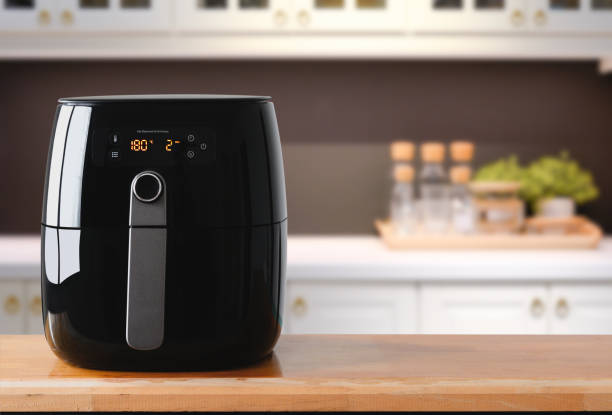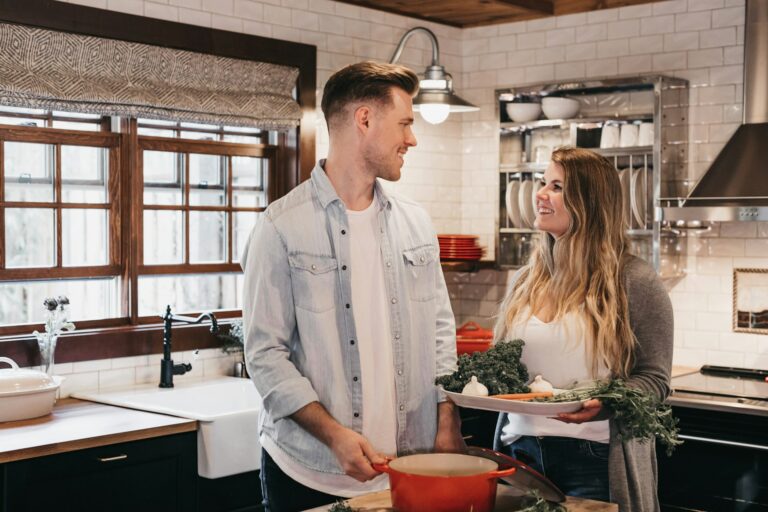How to Organize Your Kitchen For Cooking: Best Practices
Organizing your kitchen for cooking is akin to setting the stage for a performance. The better the arrangement, the smoother the show. A well-organized kitchen not only makes cooking more enjoyable but also enhances efficiency and safety.
Whether you’re a seasoned chef or a home cook, the right setup can transform your cooking experience. Let’s explore how to create an organized and functional kitchen space.
Organize Your Kitchen For Cooking:
The heart of the home beats in the kitchen. It’s where meals are crafted with care, memories are baked, and skills are honed. However, a chaotic kitchen can turn cooking into a task rather than a pleasure.
Organizing your kitchen for cooking is about creating a flow that aligns with your culinary routine, enabling you to find and use items with ease. Let’s delve into the strategies and tools that can help you achieve an organized kitchen.
Also Read: How Do You Use an Air Fryer for The First Time
1.Tips for Setting Up Your Kitchen
Crafting a Culinary Haven
Consider the ‘work triangle’ concept, which connects the stove, sink, and refrigerator. Your kitchen should allow you to move swiftly and safely between these three points. Group related items together-keep pots and pans near the stove and dishes close to the dishwasher.
Use drawer dividers for utensils and a spice rack for seasonings. Keep counters clear except for frequently used appliances. Good lighting and a comfortable working height for counters will further enhance your cooking experience.
Also Read: How to Cook Rice, the Asian Way
2. Get Kitchen Organizing Tools
The Helpers of Harmony
Equipping your kitchen with the right organizing tools can make a world of difference. These aids help keep everything in its place and within reach when you need it.
- Drawer Dividers: For separating utensils and gadgets.
- Cabinet Organizers: To maximize vertical space for plates and cups.
- Spice Rack: To keep spices visible and accessible.
- Pot Racks: For hanging pots and pans, saving cabinet space.
- Under-Shelf Baskets: To utilize empty space beneath shelves.
- Lazy Susans: For easy access in corners and under the sink.
- Wall-Mounted Holders: For tools like foil and kitchen wrap.
- Clear Storage Containers: To neatly store and stack dry goods.
Also Read: How to Enjoy Cooking Even on Busy or Stressful Days
3. Must-Have Kitchen Tools
The Essentials for Effortless Cooking
A well-stocked kitchen is the backbone of good cooking. However, it’s not about having a multitude of gadgets but rather the essentials that make cooking efficient and enjoyable.
- Chef’s Knife: A versatile knife for chopping, slicing, and dicing.
- Cutting Board: Durable and easy-to-clean, ideally one for meats and another for vegetables.
- Mixing Bowls: In various sizes for preparation and mixing.
- Measuring Cups and Spoons: For precise ingredient portions.
- Spatula: Both for mixing and turning foods in pans.
- Whisk: For emulsifying dressings and beating eggs.
- Tongs: For flipping and serving.
- Peeler: For vegetables and fruits.
- Colander: For draining pasta and washing produce.
- Saucepans and Skillets: In a couple of sizes for various cooking needs.
Also Read: Your Guide to Always Keeping Things Clean
4. Declutter, Upcycle, and Donate
Embracing Simplicity in the Kitchen
The journey to an organized kitchen begins with decluttering. Sift through your kitchen items periodically and ask yourself what you truly use. If gadgets, utensils, or appliances haven’t been used in the past year, it’s time to let them go.
Upcycle items where possible to give them a new life, perhaps repurposing a large bowl as a fruit basket. For items in good condition that no longer serve you, consider donating them to a local charity or giving them to someone who needs them.
This process not only clears your space but also clears your mind, making cooking less complicated and more enjoyable.
Also Read: Tips for Choosing a Perfect Kitchen Knives Set
5. Create Different Storage Zones
The Strategy of Segmentation
An efficient kitchen is zoned for various tasks. Designate specific areas for food preparation, cooking, and cleaning. Within these zones, organize items by their frequency of use and relevance to the activity.
For instance, store all your baking ingredients and tools together in a ‘baking zone.’ This could include flour, baking powder, measuring spoons, and mixing bowls. By creating these zones, you reduce the time spent searching for items and make the process of cooking more intuitive.
Also Read: Here is How Cooking Helps with Stress
6. Devote One Cabinet to Items You Access Daily
The Convenience Cabinet
Identify the tools and equipment you use every day and allocate a cabinet or shelf within easy reach for these items. This could include your favorite pots and pans, your daily dinnerware, or the coffee maker.
By having a dedicated spot for these essentials, you reduce clutter on the counter and make your daily cooking routine more efficient. Ensure this area is easy to access, simplifying your day-to-day kitchen tasks.
7. Keep the Shelves Organized
The Art of Shelf Arrangement
Shelves are often a focal point in a kitchen and keeping them organized is both aesthetically pleasing and functional. Group similar items together, such as glassware or dinner plates, and stack them neatly.
Consider using shelf risers to create more vertical space. For open shelving, maintain a balance between decorative items and those you use regularly.
Keep the items you reach for most often on the lower shelves and the less frequently used items higher up. An organized shelf system will streamline your workflow and add to the overall calm of your kitchen space.
8. Keep the Drawers Organized
The Discipline of the Drawers
Drawers are the hidden heroes of kitchen organization. Keeping them orderly can dramatically improve your cooking efficiency. Use dividers to separate utensils or containers to corral smaller items like measuring spoons.
Drawer organizers can also be customized to fit your specific tools and gadgets. Ensure that every item has a designated spot so that even in the rush of cooking, everything can be easily found and put back in its place.
9. Keep the Cabinets Organized
The Orderly Cabinet Approach
Cabinets often house a variety of kitchen items, and without a system, they can quickly become a jumble. Organize your cabinets by grouping similar items together, such as baking ingredients, pots and pans, or dishware.
Use stackable shelves to make the most of vertical space and turntables for hard-to-reach corners. Clear out items that don’t belong and rehome them to their proper place. An organized cabinet should allow you to see everything at a glance without having to rummage through.
10. Have Vertical Storage in the Kitchen
Maximizing Vertical Real Estate
Vertical storage solutions can be a game-changer in small kitchens or for those with limited cupboard space. Install hooks under cabinets for mugs, a magnetic strip for knives, or hang a ceiling pot rack.
Utilizing wall space for storage not only frees up valuable cabinet and counter space but also puts your kitchen tools within easy reach. This approach to storage encourages you to keep only what you need and love, as it will be on display.
11. Label Everything if You Can
The Clarity of Labels
Labels are the secret ingredient to maintaining long-term organization. They can be particularly useful for food storage containers, helping you quickly identify ingredients. This is especially helpful for items stored out of their original packaging or for bulk-bin purchases.
Labels are also beneficial for expiration dates, cooking instructions, or noting allergens. With a labeling system, you’ll spend less time searching and more time cooking.
Wrapping Up:
Transforming your kitchen into an organized space for cooking is an investment in your culinary passion and peace of mind. An orderly kitchen with organized drawers and cabinets, coupled with effective use of vertical space, sets the stage for an enjoyable cooking experience.
Labels add an extra layer of efficiency, ensuring that everything you need is identifiable and accessible. These strategies not only streamline your cooking process but also contribute to a more relaxing and inspiring kitchen environment.
As you implement these organizational tips, you’ll notice a significant reduction in the time spent searching for items, allowing for more time to be channeled into the creative process of cooking.
Additionally, an organized kitchen can inspire better eating habits, as the ease of meal preparation increases. Above all, these steps towards organization foster a sense of serenity and control within your kitchen, which is often reflected in the dishes you create and the joy you find in cooking them.
In sum, a well-organized kitchen is not just about neatness; it’s about creating a functional space that resonates with the rhythm of your home and your life. It’s a space where each tool and ingredient has its place, and every meal is an opportunity to celebrate the joy of cooking in an environment designed for culinary success.






